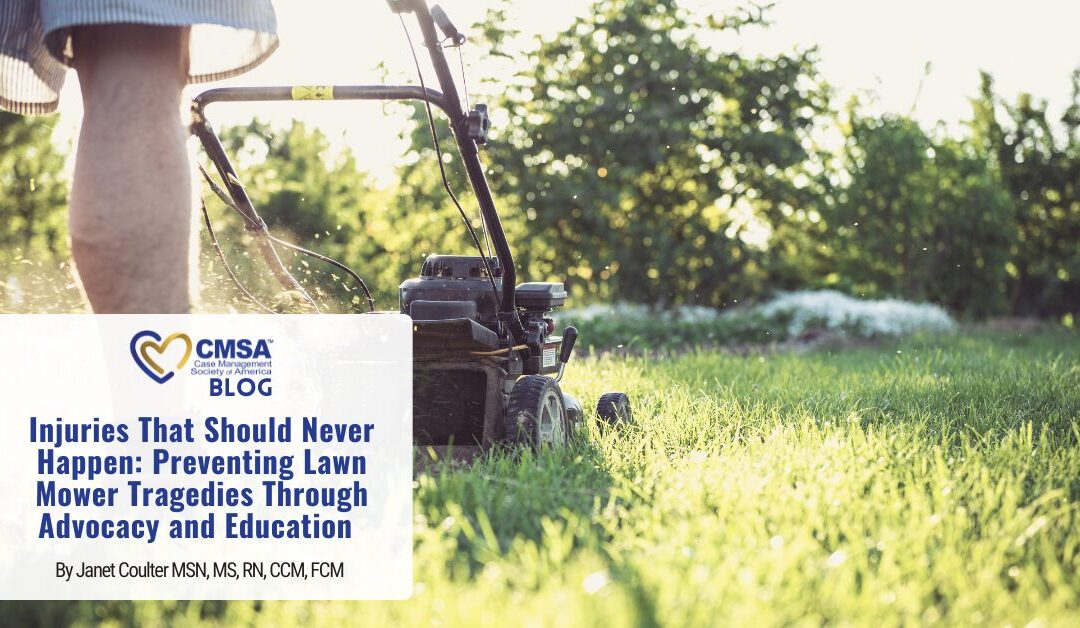By Janet Coulter, MSN, MS, RN, CCM, FCM
Summer lawns should grow memories, not emergency room visits. Each summer, lawns across America become the backdrop for family time, outdoor activities and, unfortunately, too many preventable injuries. Lawn mower-related accidents are a significant cause of serious injuries, especially among children. For case managers, understanding lawn mower safety is critical to injury prevention.
According to the American Academy of Pediatrics (AAP), approximately 9,400 children under the age of 18 are treated in U.S. emergency rooms each year for lawnmower-related injuries (AAP, 2021). These injuries range from deep cuts and fractures to amputations and even death. Adults are not immune either. Misuse, fatigue, and mechanical failures contribute to thousands of adult injuries annually.
Children under five are particularly vulnerable. Often, injuries occur when young children are nearby and out of sight of the operator. Many parents mistakenly view lawnmowers as safe “rides.” Tragically this can lead to devastating accidents. These accidents could involve traumatic amputations or crush injuries. As case managers, we must emphasize that no child should ever ride as a passenger on a mower, no matter how short the trip.
Adults face their own set of risks. These risks are primarily related to mechanical misuse, improper maintenance, and neglecting protective measures. Data from the U.S. Consumer Product Safety Commission (CPSC, 2022) reveals that roughly 35,000 adults are treated annually for lawn mower-related injuries. Concussions, broken bones, lacerations, and eye injuries are among the most common.
Preventing these injuries requires a multi-pronged approach including education and enforcement of safe behaviors. Case managers can play a vital role by incorporating lawnmower safety discussions into patient care plans, especially for families with young children, elderly caregivers, or patients returning to outdoor activities after injury or surgery.
Key recommendations from the American Society for Surgery of the Hand (ASSH, 2021) include:
- Children under 12 should not operate walk-behind mowers.
- Children under 16 should not operate ride-on mowers.
- Always wear sturdy shoes (not sandals) and safety glasses.
- Remove debris from the lawn before mowing to prevent projectiles.
- Never pull a mower backward unless absolutely necessary.
- Turn off the mower and wait for blades to stop completely before crossing gravel paths or removing clogs.
Beyond physical safety, case managers must also recognize the emotional trauma associated with lawn mower injuries. Amputations or disfigurements can lead to significant psychological distress for both children and adults. Early referral to mental health support and peer support groups can be crucial elements of a comprehensive recovery plan. Community education initiatives such as safety fairs, school-based programs, and local health department partnerships provide additional avenues for case managers to champion injury prevention.
Case managers should also be aware of the latest research on lawn mower safety. Studies have shown that children are more susceptible to severe injuries due to their smaller size and lack of experience. These injuries often require extensive medical treatment and rehabilitation, which can be both physically and emotionally taxing. Case managers need to be proactive in educating families about the risks and proper safety measures. In addition, case managers need to stay up to date with the latest safety guidelines and technological advancements in lawnmower design. Features such as automatic shutoffs, no-mow-in-reverse mechanisms, and improved blade guards can significantly reduce the risk of injury. Ensuring that patients and their families are aware of these advancements and encouraging the adoption of newer, safer equipment can make a substantial difference.
In addition to focusing on individual cases, case managers can advocate for broader community and policy changes. Promoting the use of public service announcements and social media campaigns can raise awareness about lawnmower safety. Collaborating with local government officials to implement safety standards and regulations can create a safer environment for everyone. Integrating these strategies not only lessens physical risks but also empowers the community with knowledge and resources to prevent injuries proactively.
Advocating for legislative measures to mandate safety features on all new lawnmowers can be a powerful strategy. By working alongside policy makers and industry stakeholders, case managers can help to drive the implementation of regulations that mandate such safety enhancements, ultimately fostering a safer environment for all.
In closing, lawn mowing should be a symbol of summer’s simple joys, not a cause of lifelong trauma. Case managers can lead the charge in promoting safety through prevention education, patient-centered planning, and community engagement. A few minutes of education today can prevent a lifetime of regret tomorrow.
We can change things by championing safety!
The learning doesn’t stop when the session ends.
With CMSA’s digital conference access, you’ll get on-demand recordings of main sessions—perfect for earning CE and catching every expert insight, anytime.
![]() Learn more: https://cmsa.societyconference.com/
Learn more: https://cmsa.societyconference.com/
References
- American Academy of Pediatrics. (2021). Lawn mower safety tips. Retrieved from https://www.aap.org
- U.S. Consumer Product Safety Commission. (2022). Injury statistics and prevention for lawn mowers. Retrieved from https://www.cpsc.gov
- American Society for Surgery of the Hand. (2021). Lawn mower injury prevention tips. Retrieved from https://www.assh.org
Bio: Janet Coulter, MSN, MS, RN, CCM, FCM is President of CMSA. She is a transplant case manager with a wide variety of experiences including educator, administrator, team leader, and Director of Case Management. Janet holds a Master of Science in Nursing from West Virginia University and a Master of Science in Adult Education from Marshall University. She has published many articles in CMSA Today and the Professional Case Management Journal and served as a reviewer for the Core Curriculum for Case Management Third Edition. She has served as President-Elect of CMSA, Chair of the CMSA Today Editorial Board, Chair of the Nominations Committee, and Vice-President of the CMSA Foundation board. Janet was the recipient of the CMSA National Award of Service Excellence and Southern Ohio Valley CMSA Case Management Leadership award and was recently inducted as a Case Management Fellow from CMSA.

